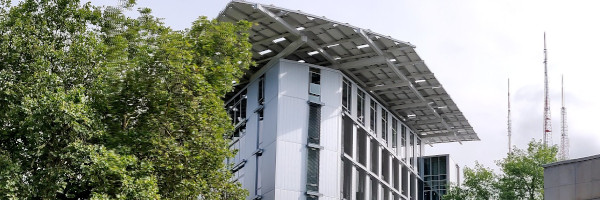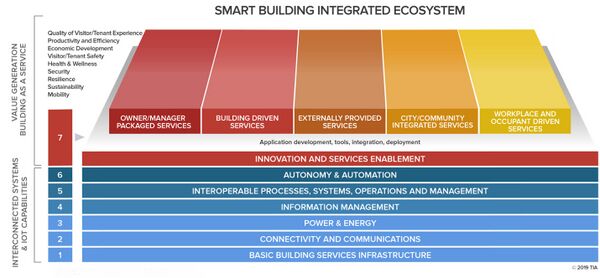Smart Buildings: Difference between revisions
No edit summary |
No edit summary |
||
| Line 28: | Line 28: | ||
<span align="center" id="Figure: Building as a Service/Space as a Service"></span> | <span align="center" id="Figure: Building as a Service/Space as a Service"></span> | ||
[[File:SmartBuildingIntegrationEcosystem.jpg|thumb|600px|center|<div style='text-align: center;'>'''Building as a Service/Space as a Service (Source TIA)'''</div>]] | [[File:SmartBuildingIntegrationEcosystem.jpg|thumb|600px|center|<div style='text-align: center;'>'''Building as a Service/Space as a Service (Source TIA)'''</div>]] | ||
Some examples of the features that can be found in a smart building include: | Some examples of the features that can be found in a smart building include: | ||
| Line 38: | Line 39: | ||
*'''Smart parking systems''': that enable efficient use of parking spaces, by guiding the drivers to the nearest available space, and also can be integrated with parking payment systems. | *'''Smart parking systems''': that enable efficient use of parking spaces, by guiding the drivers to the nearest available space, and also can be integrated with parking payment systems. | ||
Smart buildings are designed to be more energy-efficient, comfortable, and convenient for the people who use them. They also can be more resilient and adaptable to changing situations, and can save costs in the long run. | Smart buildings are designed to be more energy-efficient, comfortable, and convenient for the people who use them. They also can be more resilient and adaptable to changing situations, and can save costs in the long run. | ||
The data of digitization flows like lifeblood into systems, thereby enabling these systems, platforms and applications to interact and adapt with one another. In a smart building, this data flow can: support the optimized operations of a building; connect the desires of an occupant with building capabilities to provide a personalized, reconfigurable environment; optimize energy usage or enable energy to flow from one building to another through a microgrid system; provide visibility into occupant location, tracking; and other functions. | |||
In addition, digitized data brings to life building information models (BIM) used in construction and '''digital twins''' [[CiteRef::DigTwin2023]] (digitized reflections of real-world objects). Digital twins can now be applied to buildings. These high-fidelity building digital twin models present data collected from complex disparate systems which support a building. Two and three-dimensional interfaces and dashboards present the data to show system activity, enabling in-depth review of current status and predictive analysis. Digital twins allow for simulations and “what if” analyses to see optimal approaches for future operations and/or upgrades and augmentations. They are also increasingly being used during architectural design and development, construction, day-to-day operations and maintenance both for individual buildings and across property portfolios. Digital twins are also being used to design, develop and operationalize new city developments for buildings, parks and transportation and related infrastructure (E.g., India, Singapore). | |||
Revision as of 20:50, August 6, 2023
| Smart Buildings | |
|---|---|

| |
| Introduction | |
| Contact | Jiri Skopek |
| Topics | |
| NEWS
| |
- Authors
Smart Buildings is a fast-developing subject area.
Since the writing of the NIST Global City Teams Challenge [[1]] Smart Building Supercluster’s “[|Smart Buildings Blueprint]” in 2020 there have been significant advancements in this sector. This led to the need to update the blueprint with the latest information including references to the Smart Building KPIs, based on the NIST “[for Holistic Key Performance Indicators for Smart Cities (H-KPIs)]”
The online version follows the chapters of the original blueprint. These are:
- [Buildings O&M]
- [Organizational and Individual Productivity and Wellness of Smart Buildings]
- [Building-related Mobility]
- [Efficient and Connected Buildings (GEBs)]
- [Interfacing Smart Buildings with City Services and Infrastructure]
- [Cybersecurity for Smart Buildings]
Defining the Smart Building
A smart building is a building that uses technology and data to improve its energy efficiency, comfort, and functionality including the use of automatic control of the building's operations including heating, ventilation, air conditioning, lighting, security and other systems, maximizing user comfort while minimizing energy consumption.
To maximize the opportunity smart building’s offer, it is important to set a foundation of understanding by defining what is a smart building. To that end, the smart building definition and model adopted by the SBSC as a guideline was developed by the Telecommunications Industry Associations (TIA’s) Smart Buildings Program. It defines a smart building as one which “interoperates and integrates systems, technologies and infrastructure to optimize building performance and occupant experience.” This creates the building which integrates and interoperates across fundamental building systems, communications infrastructure, power and energy infrastructure, through the use of data and autonomous, intelligent processing to provide any number of valued services to building owners, operators, occupants and visitors. Further, this smart, integrated system-of-systems built environment serves the needs of these stakeholders in real-time, providing the experience (contextualized data) when, where and how they want it. Now occupants and property owners can make informed decisions of what they want to do in and with that property. Through smart buildings systems and technologies, the property asset now becomes a platform that offers services – it enters the domain of Building as a Service, and Space as a Service #Figure: Building as a Service/Space as a Service.
Some examples of the features that can be found in a smart building include:
- Intelligent heating, ventilation, and air conditioning (HVAC) systems: that use sensors and automation to adjust the temperature and air flow to optimize energy efficiency and comfort
- Smart lighting systems: that use sensors and controls to adjust lighting levels in response to changes in ambient light and activity levels, also can be integrated with occupancy sensors to lower energy consumption
- Building automation systems: that use data and automation to control and monitor various systems within the building, such as elevators, security, and fire safety systems
- Energy management systems: that use data and analytics to monitor and optimize the building's energy usage
- Connected devices and Internet of Things (IoT) technology: to enable monitoring and control of building systems remotely
- Smart metering systems: that enable real-time monitoring of energy usage and costs
- Smart parking systems: that enable efficient use of parking spaces, by guiding the drivers to the nearest available space, and also can be integrated with parking payment systems.
Smart buildings are designed to be more energy-efficient, comfortable, and convenient for the people who use them. They also can be more resilient and adaptable to changing situations, and can save costs in the long run.
The data of digitization flows like lifeblood into systems, thereby enabling these systems, platforms and applications to interact and adapt with one another. In a smart building, this data flow can: support the optimized operations of a building; connect the desires of an occupant with building capabilities to provide a personalized, reconfigurable environment; optimize energy usage or enable energy to flow from one building to another through a microgrid system; provide visibility into occupant location, tracking; and other functions.
In addition, digitized data brings to life building information models (BIM) used in construction and digital twins DigTwin2023 (digitized reflections of real-world objects). Digital twins can now be applied to buildings. These high-fidelity building digital twin models present data collected from complex disparate systems which support a building. Two and three-dimensional interfaces and dashboards present the data to show system activity, enabling in-depth review of current status and predictive analysis. Digital twins allow for simulations and “what if” analyses to see optimal approaches for future operations and/or upgrades and augmentations. They are also increasingly being used during architectural design and development, construction, day-to-day operations and maintenance both for individual buildings and across property portfolios. Digital twins are also being used to design, develop and operationalize new city developments for buildings, parks and transportation and related infrastructure (E.g., India, Singapore).



